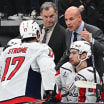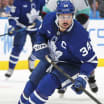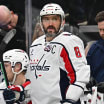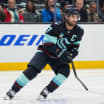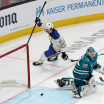It hasn't been a good week for seldom-used backup goaltenders playing behind workhorse starters in the NHL.
Curtis McElhinney of the Columbus Blue Jackets, Anton Khudobin of the Boston Bruins and Jonas Gustavsson of the Edmonton Oilers each were placed on waivers, putting 441 games of combined NHL experience up for grabs to any team that wanted it.
Backup goalies fighting mental, physical traps
Curtis McElhinney, others wrestle with factors starters rarely experience

By
Kevin Woodley
NHL.com Independent Correspondent
The Toronto Maple Leafs acted on the opportunity, claiming McElhinney before ending their own experiment with veteran backup Jhonas Enroth by trading him for a seventh-round pick in the 2018 NHL Draft to the Anaheim Ducks, who promptly sent him to San Diego of the American Hockey League.
The moves highlight an interesting problem in the NHL: Every team wants a reliable backup, but finding one who can do the job well, especially with long gaps between starts, isn't always easy. That's partly because it's such a unique and difficult role.
"After the daily physical and mental grind of being a backup, being a starter was like being on vacation," Chicago Blackhawks backup Scott Darling said.
Darling is 11-2-4 with a 2.31 goals-against average and .925 save percentage this season, and took over the top job while Corey Crawford was recovering from an appendectomy in December. But Darling knows how tough it can be when you're not playing regularly.
"It's hard to replicate real game situations in practice, so you're not seeing the same kind of plays you're going to see in that game you get every 2-3 weeks," he said. "Plus there is the pressure of knowing it's your only game for the month and you want to do well. You don't get to play poorly and just move on to the next game for redemption."
That pressure didn't decrease with the recent moves.
"There's no forgiveness anymore," said Chris Mason, who started and ended his nine full NHL seasons as a backup. "Points are so valuable, teams are not waiting for guys to play out of a slump. It's becoming kind of an expendable position now with proven guys getting sent down left and right this year. This is kind of a new phase in the NHL."
Mason, who works as an analyst on Nashville Predators broadcasts and as a goalie coach with the junior Predators in the North American Hockey League, isn't sure there's any one perfect formula for finding an ideal backup goalie to play behind a workhorse No. 1.
"There's no right answer because every guy handles it different," he said. "You really do have to have a different mentality. It's a mindset you have to come to terms with."
Alex Auld knows the challenges well after spending five of his 10 NHL seasons mostly in backup roles. He believes it requires a different mental approach to practice.
"It takes a certain personality," Auld said. "It takes a person super-committed to having practice be their most important thing. A true starter knows what they need and just gets through the rest, kind of survives practice. But for a backup, practice is like their game."
Mason also cited practice approach and said he found the backup role easier early in his career than at the end, after four straight seasons of 40 or more games with Nashville and the St. Louis Blues. So maybe it's not a coincidence that most of the goalies succeeding in a limited role this season are relatively new to the NHL.
Nashville rookie Juuse Saros has a 1.25 GAA and .957 save percentage in seven starts behind Pekka Rinne. However, like Darling in his rookie season, Saros, 21, also has spent time in the AHL to stay sharp between some of his starts. Rookie Aaron Dell, 27, has a 1.96 GAA and .929 save percentage in seven games (six starts) behind Martin Jones with the San Jose Sharks. Philipp Grubauer, 25, has a 1.94 GAA and .929 save percentage through nine games of his second full season playing behind workhorse Braden Holtby with the Washington Capitals. Minnesota Wild backup Darcy Kuemper is in his fourth NHL season at age 26, and has a 3.21 GAA and .902 save percentages in eight games behind Devan Dubnyk.
Veterans Enroth (.862), Gustavsson (.878) and Khudobin (.885) all had save percentages below .900, and none is in the NHL. The only other healthy goalie to play less than 10 games in the League this season is McElhinney, who had a 2.39 GAA and .924 save percentage before the Blue Jackets placed him on waivers Monday. McElhinney, 33, seems to understand the job requires a different mindset.
"It's challenging but it's far more rewarding now that I am a little more experienced at it," McElhinney said prior to backing up Sergei Bobrovsky in mid-December. "I don't think you get caught up in it as much when you are older, especially if you are still doing the same role. I have essentially been in this role from start to finish in my career at this level. I think now I'm just more comfortable with it; used to your own skin, I guess."
There's a fine line between comfort and complacency, and McElhinney worked hard to modernize his technique during his time in Columbus, knowing infrequent starts make it tougher to find the timing active goalies rely on more heavily. In theory, a more efficient, neutral-position style should leave a goalie less reliant on the rhythm that comes from regular starts, but finding that balance can be a different process for every goalie.
Going back to playing regularly after settling in as a backup can be just as hard, which is why some who succeed in sporadic starts can struggle when the No. 1 gets hurt.
"The one real risk I see, and I think it happened to me, is the good backups that become veterans at that, they almost give themselves to the role so much that in some ways they close the door to being a starter again," Auld said. "You become comfortable in that role, just like a starter that is playing all the time would have trouble going back to not playing. If you become really good at it, it becomes hard to go the other way."
For a handful of teams this season, it's a risk they'd take if it meant finding the right backup behind their workhorse No. 1.


